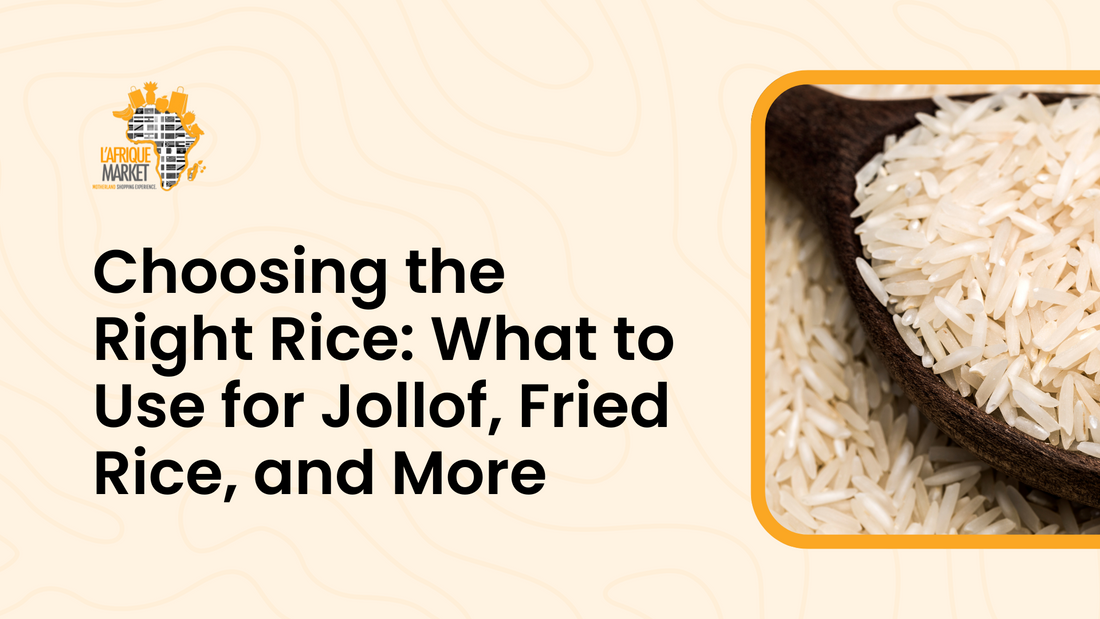
Choosing the Right Rice: What to Use for Jollof, Fried Rice, and More
Share
Rice, a favorite staple in every home.
So popular, that for many of us growing up, the phrase "there’s rice at home 😂" was code for: We’re not stopping at that restaurant. Let’s go. No matter where you're from in Africa, rice has probably saved the day more than once.
Quick to cook, endlessly versatile, and guaranteed to satisfy, from Sunday stew to weeknight fried rice, it’s always been that dependable go-to, easy-to-whip-up meal on your plate.
But here’s the thing: not all rice is created equal.
If you’ve ever made soggy Jollof or ended up with clumpy fried rice that just wasn’t giving, the culprit might not have been your cooking skills, it could’ve been your rice.
Let’s talk about how rice is grown, how to choose the best one for each meal, and a little guide to help you never pick the wrong grain again.

So, Where Does Rice Come From?
Rice isn’t grown only in Asia. Countries like Nigeria, Ghana, Mali, and Senegal grow and process tons of rice every year.
These grains are either upland (grown without flooding) or lowland (grown in flooded paddies), depending on the climate and soil. After harvesting, the rice goes through a process of drying, milling (removing the husk), polishing (sometimes optional), and sorting before it lands on store shelves and eventually, your kitchen.
Fun fact: Local rice varieties — like Ofada — are often unpolished, meaning they keep more nutrients and flavor. Imported ones are usually more polished and longer-grained, giving that picture-perfect plate.

Now, Which Rice Should You Use? Let’s Talk Types
1. Long Grain Parboiled Rice
The classic. Tough enough to survive Jollof heat, yet tender enough to soak in stew.
Best For: Jollof rice, Fried rice, White rice + stew
Texture: Non-sticky, holds shape, cooks evenly
Bonus: It’s parboiled before milling, so it’s already a little prepped for you!

2. Basmati Rice
Fragrant, long, and light, basmati is what you reach for when elegance is the goal.
Best For: Fried rice, stir-fried dishes, coconut rice
Texture: Fluffy, fragrant, cooks quickly
Bonus: Doesn’t clump or stick and is ideal for Instagram-worthy plates

3. Ofada (Local Unpolished Rice)
A taste of home in every bite. Earthy, rich, and best served with spicy pepper sauce.
Best For: Ofada sauce, native rice dishes
Texture: Slightly sticky, brownish in color, has a funny smell
Bonus: Higher in fiber and more filling
Just don’t forget to rinse it well and maybe de-stone it, the local authenticity comes with character 😅

4. Medium/Short Grain Rice
These softer grains are for comfort food days.
Best For: Rice porridge, tuwon shinkafa, baby food
Texture: Sticky, soft, absorbs liquid well
Bonus: The grain of choice for dishes where mushy = delicious

Quick Rice Guide for Cooking
| Dish | Best Rice Type | Why It Works |
|---|---|---|
| Jollof Rice | Long Grain Parboiled | Holds up to long cooking and tomato sauce |
| Fried Rice | Basmati or Long Grain | Fluffy and light, doesn't clump |
| Ofada Sauce (Ayamase) | Ofada (local) | Traditional texture and flavor |
| Rice Porridge | Short/Medium Grain | Soft and creamy |
| White Rice + Stew | Long Grain or Ofada |
Personal preference on texture |
Bringing It All Together
By now, you’ve probably realized rice isn’t just rice. The grain you choose can make or break your dish, from that smoky Jollof everyone craves, to the colorful fried rice that disappears first at every party.
The key? Knowing your grains and cooking them right.
And if you’ve ever faced the heartbreak of soggy rice (we’ve all been there), don’t toss it just yet; check out these 3 quick tips on how to fix it and avoid it next time.
When you're ready to cook, we’ve made it easy to find the grains and spices that bring your favorite dishes to life, the ones that smell like Saturday afternoons at home.
Browse our rice and spice collection stocked for home cooks, foodies, and kitchen pros alike.
